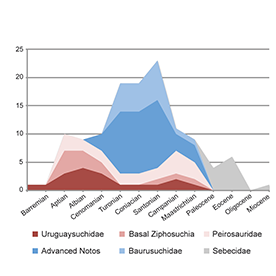DIVERSITY PATTERNS OF NOTOSUCHIA (CROCODYLIFORMES, MESOEUCROCODYLIA) DURING THE CRETACEOUS OF GONDWANA
DOI:
https://doi.org/10.5710/PEAPA.10.06.2015.108Abstract
Notosuchia is a diverse clade of Crocodyliformes that achieved a remarkable diversity during the Cretaceous. This group is particu- larly abundant in continental deposits of Gondwana throughout the Cretaceous, especially in South America. Notosuchia was first recognized as a distinct group by the early work of Gasparini in the 1970’s and in the last decades numerous discoveries and studies have increased the geographical, temporal and taxonomical scope of this clade. Here we analyze the patterns of diversity of Notosuchia during the Creta- ceous, considering their taxic and phylogenetic diversity, as well as implementing sampling corrections aiming to account for the uneven fossil record of different stages of the Cretaceous. We identify two subsequent pulses of diversification in the late Early Cretaceous and the middle Late Cretaceous, followed by two separate extinction events that occurred during the latest Cretaceous (Campanian/Maastricht- ian). We discuss the contribution of the South American, African, and Malagasy fossil records to the diversity curves, which indicates the African fossil record dominates the first pulse of diversification and the South American fossil record exclusively compose the second pulse of diver- sification. Finally, we analyze the patterns of diversity shown by the different subclades of Notosuchia throughout the Cretaceous, which reveal markedly different evolutionary dynamics of four major groups of notosuchian crocodyliforms.

Downloads
Published
Issue
Section
License
Copyright (c) 2015 Publicación Electrónica de la Asociación Paleontológica Argentina

This work is licensed under a Creative Commons Attribution-NoDerivatives 4.0 International License.
Authors retain copyright and grant the journal right of first publication with the work simultaneously licensed under a Atribución/Reconocimiento 4.0 Internacional that allows others to share the work with an acknowledgement of the work's authorship and initial publication in this journal.















